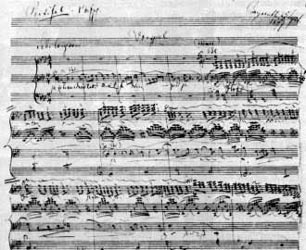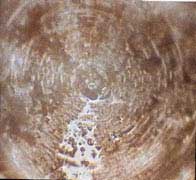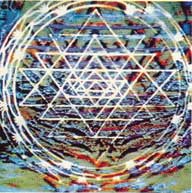This is copied from the site below, which presents some interesting thinking........

Wagner's original score to Parsifal; listen to: Good Friday Spell or (Prelude to Act 1)




It may be the greatest secret on the spiritual path. Most of today's music is a hindrance not a help. This has been written about from ancient Greece and even more so today but has fallen on deaf ears. Why? Because this very same music makes us feel good, relieves our stress and tensions, releases anger and we're happier listening to it, so it can't be bad.Sources and other books on Music:
Before investigating why feeling good may be bad, lets review the evidence published and otherwise documented.
Dr. John Diamond published a book called BK, Behavioral Kinesiology, later changed to Your Body Doesn't Lie. He relates the story of feeling terrible one fine day in New York City. Being a health practitioner set him on a path of deduction. He wanted to know what common elements over two days made him feel ill. The only thing he could come up with was a visit to the record store Sam Goodys each day. But why would that effect him that way? The clue came when he realized the same song was played both days in the store. Voila! the common denominator. He just happened to be an expert in kinesiology and so began his odyssey of muscle testing himself and other people listening to various kinds of rock and roll for that is what he heard in Sam Goodys. The results startled him. The harder the 'rock' the weaker people became. From that harmless side trip to a record store, began a new career for Dr. Diamond. He has gone on to write several books on the positive side of music, discovering that even the consciousness and abilities of a conductor can effect how much 'energy' comes from a performance or recording.
In their 1973 classic, The Secret Life of Plants, Peter Tompkins and Christopher Bird devote a whole chapter on how music affects plants, called 'The Harmonic Life of Plants.' Dr. T.C. Singh, head of the Dept. of Botany at Annamalai University discovered that ragas helped plants grow. He observed this down to the microscopic level as well. They go on to describe several other experiments in Canada and the United States in the 50's and 60's where plants and crops grew faster and healthier when listening to Bach, Gershwin and certain sound frequencies.
The book continues to relate the story of a former organist and mezzo soprano, Mrs. Retallack, who decided to become a biology student. She remembered one of those experiments using music and set out to do some controlled experiments with her Professor, Francis Broman. Two other students intrigued by Mrs. Retallack's lead, conducted their own tests and:
"ran an eight-week experiment on summer squashes, broadcasting music from two Denver radio stations into their chambers, one specializing in heavily accented rock, the other in classical music.She went on to address critics by showing that plants indeed did shun rock music. She played rock first on one side of the plants then on the other. Each time the plants turned away, growing in the opposite direction. She went on to test various types of music and percussive sounds with varying results. Her research gained her exposure in newspapers and even on CBS. Some of this notoriety also brought the usual bag of skeptical scientists who immediately dismissed the findings with flippant remarks like, 'plants have no ears.'
The cucurbits were hardly indifferent to the two musical forms: those exposed to Haydn, Beethoven, Brahms, Schubert, and other eighteenth and nineteenth-century European scores grew toward the transmitter radio, one of them even twining itself lovingly around it. The other squashes grew away from the rock broadcasts and even tried to climb the slippery walls of their cage.
Impressed with her friends' success, Mrs. Retallack ran a series of similar trials early in 1969 with corn, squash, petunias, zinnias and marigolds; she noticed the same effect. The rock music caused some of the plants first to grow either abnormally tall and put out excessively small leaves, or remain stunted. Within a fortnight all the marigolds had died, but only six feet away identical marigolds, enjoying classical strains, were flowering. More interestingly, Mrs. Retallack found that even during the first week the rock-stimulated plants were using much more water than the classically entertained vegetation, but apparently enjoying it less, since examination of the roots on the eighteenth day revealed that soil growth was sparse in the first group, averaging only about an inch, whereas in the second it was thick, tangled, and about four times as long." The Secret Life of Plants, p. 154-155
In another study, reported by Insight Magazine, April 4, 1988, physicist Dr. Harvey Bird (Fairleigh Dickinson University) and neurobiologist Dr. Gervasia Schreckenberg (Georgian Court College) wanted to see how music affects animals. They used three groups of mice. One group heard voodoo music, another Strauss Waltzes and the third silence. The music was played at low levels so that loud volume would not be a factor. The mice had to run through a maze to find their food. The mice that listened to the voodoo music had a difficult time finding the food until it got so bad they were hopelessly lost. The other two groups had no problem finding the food. In fact, the mice listening to the Waltz music did slightly better. All groups received a break of silence for three weeks. The voodoo music group still got lost but the others had no problem finding their way back to the food. At the end of the experiments the brains were examined and compared. The rock/voodoo group did not fair well. There was excessive branching of the neuronal dentrites and significant increases in mRNA. Dr. Schreckenberg explains:
"We believe that the mice were trying to compensate for this constant bombardment of disharmonic noise," says the neurobiologist. "They were struggling against the chaos. If more connections among the neurons had been made, it would have been a good thing. But instead there were no more connections, just wild growth of the neurons. ... As a result of the exposure to the disharmonic sounds," she says, "we believe there was less capacity for memory in the exposed mice."A high school student, David Merrell, who had won awards at science fairs conducted a similar type experiment with mice and a maze. The group subjected to the rock music did far worse navigating the course. In David's words, "I had to cut my project short because all the hard-rock mice killed each other. None of the classical mice did that at all." (Nexus Magazine 12\97; Washington Times 7\2\97).
If you trace Rock back to it's roots, Big Band and Jazz, then go back a couple steps further, you'll end up in New Orleans and Haiti and ultimately back to the voodoo beat, the drum beat of Africa. Why is the beat so debilitating? One can point to syncopation or stress on the off or weak beat. For example, the Waltz has three beats with the natural emphasis on the first: One, two, three; One, two, three. Change that emphasis to the last weak beat and you get: da, da, dumb; da, da, dumb. That's a syncopated rock beat. That explains the mechanics but not the effect.
It is almost as though the first beat of the waltz is a space or cosmic interval. God sends the energy and then the soul listening, hears and feels the initial wave of life force within the heart. The interchange takes place as the soul pauses to make atunement with the God above, then responds with the second and third beats. A beat with no emphasis on any beat seems mechanized not attuned to the cosmic cadences. The emphasis on the last beat seems to make a statement that the physical plane is most important in this exchange, that the ego supercedes the Divine intent. The final beat says 'there will be no divine interchange, the energy will stay right here.'
In the beginning, we were spiritual beings, equally created and filled with Light . What we do with that Light is our choice. We have free will. This Light courses through the meridians and chakras as chi, light, fire and energy even filling the spaces in blood molecules. The major energy centers are the chakras as seen below.
- Crown (yellow)
- Third Eye (green)
- Throat (blue)
- Heart (pink)
- Solar Plexus (purple)
- Soul (violet)
- Base of the Spine (white)
© SummitLighthouse
It is these seven energy centers that get affected by the syncopation. They are intended to be spinning at different frequencies and are supposed to look like the pure colors above. Our desires, wrong behavior, thoughts, emotions and outside forces can alter the color and slow down the spinning, even stopping the wheel of the chakras completely. I hope to show that what is actually happening is that the vibration and beat of discordant music sets up a direction and flow of energy that passes through the chakras, creating friction, simulating the spinning of these chakras and therefore, making us feel good. Our chakras are so sullied by the vagaries of modern day life that we crave relief. Rock music brings those chakras back to life but only for a moment. If we had the chakras above, we would instantly recognize the assault upon our Light.
Science points to this hypothesis as it continues to explore the effects of sound impacting matter. Sound travels through the ethers in waves and patterns. Several scientists have studied how sound creates shapes and patterns. Hans Jenny used clay materials, sands, and liquids. He created the form on the left, below. This particular frequency is setting up a Tai Chi kind of flow. In another experiment (right) at the Univ. of Texas, Scientific American (November 1996) reports on a device called an oscillon. Different frequencies made tiny brass spheres form pillars (additional link).
In both experiments, many different patterns resulted. Most of the time, the medium used was lifted up, defying gravity, as if it had a mind of it's own, wanting, yearning to explore beyond it's own physical universe and limitations. While some might say the sound created heat in the liquids causing it to rise, the same cannot be said of the numerous inert substances used, such as the two above. No, it was the sound causing movement. Each frequency has it's own little dance. Imagine the effect on us, not only on our spiritual body but on the 70% of water within us.
Researcher, Masaru Emoto, has done some revolutionary work on how water is affected by sounds, words and music. He subjected water and water crystals to different sounds, even swear words. Pure water looks like a beautifully formed crystal, a unique pattern like a snow flake. Polluted water looks like mud. Normal looking water turned to the intricate crystal pattern when prayed over or when classical music was played. When negative thoughts or even words like 'Hitler' were used, it turned to an amorphous non-descript glob like the one below. This same effect happened when heavy metal rock music was played and can be seen in the picture immediately below and at this link: Miraculous Messages of Water.
Left: The music of Bach impacts a water molecule and crystal.
Right: Heavy Metal music impacting a water molecule
Go back to the plants. When they died and shriveled up but thrived with classical music, they still had physical light and nutrients in the soil. Other studies have proven that plants also have auric fields, smaller, but there. It is that energy or Light that is being siphoned away from them, causing extreme trauma even death. We have greater Light than plants and animals as God gives it to us to do with what we will, for a short time. We can use it correctly or squander it. When that beat rolls in, it presses the Light out and down, just as it did with the water crystals. It goes down to the lower chakras rather than going back to God.
As it goes down, it's passing through those sluggish chakras. The friction stimulates them. It feels good even giving people the sense of power; but the real power comes from God and is the pure Light of the chakras. The energy drops down to that bottom, base of the spine chakra, creating an over-sexed society but that 'feels good' so it 'can't be that bad.' The light is lost. Light that would have fed the other chakras on the way back to God. The love in the heart could have increased or the mind of Christ could have expanded with the opening of the crown chakra. Sex is good, but all the time? Do we need to be thinking about it as much as we do?
The spiritually inclined of old, east and west, knew these principles. Below is an ancient symbol called a Shri Yantra depicted over the centuries with slight variations but always with the interlaced triangles. It represents the Aum or Om, the unifying sound representing all sounds that come from God. It can place one in contact with God and the God in each one. The figure on the right shows the pattern when the Om is spoken into an electronic device. There are sounds and music that help mankind connect with his divine potential and with God.
Left: Indian Shri Yantra depicting the Aum mantra
Right: Aum mantra spoken into an electronic transmitter (from Ajit Mookerjee collection)
PlatoHe wrote in the Republic:"Musical training is a more potent instrument than any other, because rhythm and harmony find their way into the inward places of the soul, on which they mightily fasten, imparting grace, and making the soul of him who is rightly educated, graceful."Later he writes in the Republic about the negative effects on society:"The introduction of a new kind of music must be shunned as imperilling the whole State: since styles of music are never disturbed without affecting the most important political institutions."In Laws he wrote:"Through foolishness they deceived themselves into thinking that there was no right or wrong in music -- that it was to be judged good or bad by the pleasure it gave. By their work and their theories they infected the masses with the presumption to think themselves adequate judges ... As it was, the criterion was not music, but a reputation for promiscuous cleverness and a spirit of law-breaking."Another statue of Greek philosophy, standing equally tall in history, Aristotle said:"emotions of any kind are produced by melody and rhythm; therefore by music a man becomes accustomed to feeling the right emotions; music has thus the power to form character, and the various kinds of music based on the various modes, may be distinguished by their effects on character---one, for example, working in the direction of melancholy, another of effeminacy; one encouraging abandonment, another self-control, another enthusiasm, and so on through the series."As with many theories and studies of this nature, there is an element of faith. Hopefully more research will come to the fore. Look for it on the internet. It pops up occasionally. To understand why Plato is concerned for our souls, why Aristotle warns of character, why plants turn away from rock, why animals become disoriented and water crystals turn to mud; you can try your own simple experiment.
Pick a morning, the earlier the better. Do some prayers or mantras and meditate for at least 15 minutes or longer. Ask God, Jesus, the Blessed Virgin, or Maitreya to show you the truth. Then play some rock or rap music and meditate on what is happening. I think you'll find that the energies flow downward, not back to God but give rise to feelings of anger, sex or even a false sense of empowerment. Try to analyze that sense of power. Is it true? Does it come from God and/or your true Self or is it ephemeral, an illusory emotion whipped up by a frenetic beat?
Here's another test. Put yourself in a good space again. Wait till you're calm and attuned to the subtle vibrations of the spirit. Then listen to a traditional rendition of the Star Spangled Banner by a famous Opera star like Robert Merrill (he opens the Yankee games--hey, I just had a thought, maybe that's the real reason they've won so often. It's not the money!), or someone else who sustains notes and sings it as it is supposed to be sung. You can feel the power and majesty of the song. It is actually thrilling. The thrill is not just self generated, there is a movement of energy (and light) as demonstrated above. The sustained notes, sung with power and, yes, even love or devotion moves molecules and unseen prana, odic forces, orgone energy, chi, light, whatever you want to call it; into pathways and invisible grids of sound rays that benefit all who hear or feel the radiance emanating.
Now, listen to one of the modern versions sung at a championship game. The singers add all sorts of curlicues and ever changing notes at the end of words. Picture what happens to the clay and sand formation above, or the shri yantra. It's going to be a jangled, chaotic mess, kind of like a nightmarish picture of modern art. There is a correlation. People's emotional bodies are out of whack for various reasons. Their astral bodies may look like a Klee painting or a Picasso. Therefore this type of music and art resonates with them, so much so, they probably think I'm nuts. That's okay, some will know what I'm saying here. The quest to contact the Divine within and above, is a daily occurrence. It takes effort. Music is intended to aid that path.
The world and it's ways loves a yo-yo. The string is let out. We learn advanced spiritual techniques. We strive, do better, climb up the spiritual path of the world's mainstream religions or the feel good philosophies of today's movements. We stay at that plateau for awhile, feeling connected to God, to pure Love and wanting to serve the Christ in others. But these paths are lacking certain spiritual truths. One of these is a secret the vampires of the Spirit do not want you to know. They know how easy it is to steal the Light. The string gets jerked back. They pull on your chain. The Light garnered in the chakras is lost in a fit of anger, a moment of lust, depression, etc. Add the rock\rap beat to those emotions and you have the perfect formula for keeping the populace dumb and happy while sucking their Light and preventing them from becoming their true divine potential.
The world wants you to be a yo-yo, to love that rock and rap beat, because as we all know, it feels sooo good.William House
Editor, Reverse Spins
Amazon.com items:



















No comments:
Post a Comment